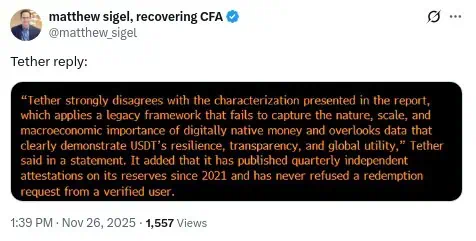
Tether has strongly rejected S&P Global Ratings' "weak" rating, arguing that the agency uses outdated metrics that ignore the real resilience of digital assets.
Tether Holdings Limited's response was swift and delivered a fundamental critique of traditional financial rating mechanisms. Following the publication of the latest S&P Global Ratings report, which downgraded the stability rating of the USDT stablecoin to the "weak" categoryThe issuing company issued a strong statement rejecting the agency's conclusions.
According to Tether, the assessment is based on a "legacy framework" that fails spectacularly to capture the nature, scale, and macroeconomic significance of digital native money.
This reaction came after S&P analysts, cited in a Bloomberg report, lowered the rating of the world's largest stablecoin by market volume.
The agency justified its decision by pointing to a worrying increase in exposure to high-risk assets within the reserves backing the stablecoin, specifically mentioning Bitcoin, gold, and corporate bonds. For Tether, however, this approach demonstrates a misunderstanding of the data which, in their view, demonstrate the resilience and transparency of their global financial operations. The company maintains that applying old-economy standards to blockchain infrastructure results in a misdiagnosis of true solvency.
Operate regulated stablecoins on Bit2MeDispute over the financial soundness of USDT
The recent downgrade of the USDT stablecoin by S&P Global Ratings has ignited a crucial debate in the crypto world. The agency made this decision based on a rigorous analysis that reveals an imbalance in the financial backing of this digital currency.
According to S&P, Bitcoin now represents 5,6% of all USDT in circulationThis exceeds the 3,9% overcollateralization margin that the company maintains as a safety net. According to the agency, this difference indicates a latent risk, because if the value of Bitcoin were to drop sharply, it could completely deplete that margin, leaving USDT without sufficient backing to maintain its parity with the dollar.
From a financial perspective, this situation highlights a mathematical vulnerability. S&P's lower rating reflects concerns about Tether's reserve capacity to absorb a drop in the value of its most volatile assets without jeopardizing the stablecoin's stability. Essentially, if an adverse market occurs, USDT could become undercollateralized, meaning that issued tokens would lack adequate backing—a scenario that would undermine user confidence and security.
In response to this criticism, Tether responded defending its operating model and the transparency it has exhibited since 2021When it began publishing independent attestations about the composition of its reserves, the company emphasized that it has never denied a legitimate redemption request, a fact it considers tangible proof of its liquidity and resilience during times of volatility. For the company, this practical reality carries more weight than traditional risk models used by agencies like S&P, which were designed for conventional financial institutions and not for the unique dynamics of cryptocurrencies.

Create your account: buy and manage stablecoins"Tether strongly disagrees with the characterization presented in the report, which applies a legacy framework that fails to capture the nature, scale, and macroeconomic significance of digitally native money and overlooks data that clearly demonstrate USDT's resilience, transparency, and global utility."the company said in the statement.
The clash between crypto innovation and traditional financial standards
The dispute between S&P and Tether goes beyond simply assigning a rating and represents the ongoing friction between two financial eras. Tether's criticism of the use of a "legacy framework" suggests that rating agencies are penalizing innovation by treating stablecoins as if they were traditional banks or money market funds regulated under rules from decades past.
On the other hand, the inclusion of assets such as Bitcoin and gold in reserves is seen by cryptocurrency advocates as a diversification and financial sovereignty strategy, while for traditional risk analysts, it constitutes an unnecessary injection of volatility into an instrument that promises stability.
S&P's mention of "limited disclosure" was also refuted by Tether, which maintains that its reports provide a clear view of its financial health. However, the rating agency argues that the lack of comprehensive audits under international standards remains an obstacle to awarding a higher rating. This debate highlights that, although cryptocurrencies have penetrated the financial mainstream, the languages spoken by token issuers and risk assessors remain, in many respects, incompatible.
Final market validation
Beyond the official statements, the debate between Tether and S&P raises questions about how the market will interpret this warning sign. Historically, USDT users have prioritized the token's liquidity and omnipresence on exchanges over concerns about the exact composition of its reserves.
A "weak" rating from an entity as prestigious as S&P is a reputational blow intended to inform institutional investors, but Tether's defiant response suggests that The company feels confident in its dominant position and the trust of its user base.
Tether's insistence that the analytical parameters used by S&P are outdated raises another important debate about whether current models that measure financial risk truly capture the unique characteristics of digital assets.
While S&P maintains a cautious and conservative approach to protect investors, Tether advocates a broader criterion, valuing practical utility and transaction efficiency. The real test will be how investors respond to future Bitcoin fluctuations, as that will determine whether S&P's warning was a necessary precaution or simply a misinterpretation of the new digital economic ecosystem.
Find the top stablecoins here

